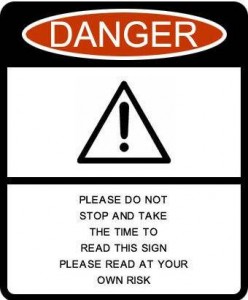Warning: Avoid the double fault. Beware of these common presentation pitfalls!
 In presentations, just like in tennis, there’s so much to remember. Bend your knees; keep your eye on the ball; follow through. So what do you need to remember when presenting? More importantly, what should you watch out for?
In presentations, just like in tennis, there’s so much to remember. Bend your knees; keep your eye on the ball; follow through. So what do you need to remember when presenting? More importantly, what should you watch out for?
As a presenter, there are many pitfalls and bad habits that reduce your effectiveness with every swing. There’s no substitute for hands-on experience, but don’t leave your practice rounds to the final tournament. Learn to recognize when you stumble on these common presentation pitfalls. Shed the bad habits.
By being more aware and intentional about how you plan, design/build and deliver your presentations, you will reap greater rewards. Your effort just might result in positive recognition, promotion and new business opportunities for you and your company. So get excited about experimenting with new, innovative presentation techniques. You just might ace your next presentation.
Below is a short list of the most common presentation pitfalls. Your job is to learn how to avoid these things.
The root causes of these 19 presentation pitfalls fall into one of three core areas:
- Bad planning
- Ineffective design
- Poor delivery
How can you avoid these pitfalls in your next presentation?
- Spraying and praying. When presenting, more is never better. If you find yourself telling your audience everything you know out of a misplaced fear that you might lose an opportunity, then you will surely lose out. Ten pounds of flour in a five-pound bag is never a winning formula.
- Neglecting your audience. Do you really know who is in your audience? Do you know their objectives? Why not spend some time researching who they are and why they are there? The insight will be worth its weight in gold.
- Copy and paste preparation. Each presentation is a unique situation. If your approach to preparing is to copy and paste old presentation material and then add more slides, you’re doing a disservice to yourself and your audience. Start each presentation with a clean sheet of paper. Literally.
- PowerPoint® addiction. Fancy does not equal effective. PowerPoint® is an over-used medium that is putting audiences to sleep. Surely you can find a more creative way to communicate your message. Go PowerPoint®-FREE for your next presentation and see how much more effective you can be with your audience. Note: PowerPoint® is a registered trademark of Microsoft Corporation.
- Do-nothings. So what do you want your audience to think/feel/do as a result of your presentation? Is your talk really just a lot of “nice to know” stuff? Failure to create action as a result of your presentation will inevitably reduce your impact.
- Assuming boring must be boring. Just because you are presenting difficult or complicated material doesn’t mean it has to be boring. Your attitude and enthusiasm about it will make all the difference. Get excited about your subject matter. It will be contagious!
- Data junkie. Facts and figures can be very impressive and convincing, but they can also bore your audience senseless. You must be aware and balance the need for intellectual stimulation along with emotional engagement. Years from now, they probably won’t remember the many data points of your presentation, but they will remember how you made them feel.
- Key message confusion. That is, confusing what you want to say with what they need to know. This is the key to your Key Message. Spend more time cultivating this vitally important aspect of your presentation. It will help you to create your desired presentation outcome.
- Winging it. Forgetting the daily mantra: Practice. Practice. Practice. Get into the habit of doing “live” rehearsals, especially of your openings and closings. Get feedback from your peers before the real deal. Rehearsing will also help you shake off any nervousness or anxiety before the actual presentation.
- Death grip security. Must you really hang onto the podium? Do you really need notes? If you know your key message and your audience, you are free to move about the room.
- Twitch and itch. So what’s up with that rubber band you’re playing with? Do you really need to click that pen? Why are you touching your face/hair so often? If you need to roll up your sleeves repeatedly, why not just take off the coat? This is very entertaining, but distracting stuff.
- Failure to repeat yourself. To make a message stick, you must repeat it multiple times. See Dr. Martin Luther King Jr.’s “I Have a Dream” speech. He not only rang the bell of freedom, but left us with a highly memorable, highly repeatable key message.
- Answering the question asked. It can be suicide. Why not build a better question and answer the better question instead? Often, your audience is not asking the question they really want answered anyway.
- Environmental disaster. The physical space, seating configuration, and audio set up of the room in which you will be presenting will impact your outcome. Don’t leave anything to chance or to last minute scrambling. Think carefully about how you want the room set up to help you elicit the desired response from your audience. Your environment will either add to or distract from your impact. Remember, it’s your presentation. Be in control.
- Elephant sightings. There’s nothing more awkward than having a big, obvious, unaddressed issue surface during your presentation. Your professional credibility will increase if you skillfully address and quickly resolve the issue. You can then move on to the business of producing your desired outcome.
- Running overtime. It seems that many presenters feel an overwhelming need to fill every minute of time that is allotted to them for their presentation. This is dangerous and could derail your next presentation. What would happen if you ended your presentation early? How would your audience feel if you gave them back an extra 10-15 minutes of time? Would they resent you or would they love you?
- Force feeding. This pitfall is best explained by brain expert and author John Medina. “Relating too much information without enough time devoted to connecting the dots. Lots of force feeding with very little digestion. This does nothing for the nourishment of the listeners whose learning is often sacrificed in the name of expediency.” The author suggests that our brains “fatigue” and need to be stimulated every 10 minutes or so. He recommends incorporating stories or metaphors in our presentations to wake up your audience and keep them engaged. This needs to be done every 10 minutes or so.
- Over-apologizing. Never start your presentation with an apology and be careful not to “mea culpa” too much during your presentation. (i.e.,Latin for ‘my mistake/my fault”). This bad habit will result in a reduction of your credibility and personal power. Keep quiet your inner critic during your presentation.
- Speaking in code. Every company has its own language understood only by those who have worked there for years. Usually the insiders use abbreviated, nonsensical language. the danger of speaking code is that those using it lose the power of the words and confuse others. You will benefit your audience if you speak in full sentences with complete words, rather than abbreviations or acronyms. You reduce the risk of being misunderstood while you tap into the full power of language and become a more effective communicator.
If you need help in overcoming these pitfalls, contact Kathy at (860) 408 0033 or via email – Kathy@AmericasMarketingMotivator.com. Ask about her signature training and coaching series, The Motivated Presenter.

